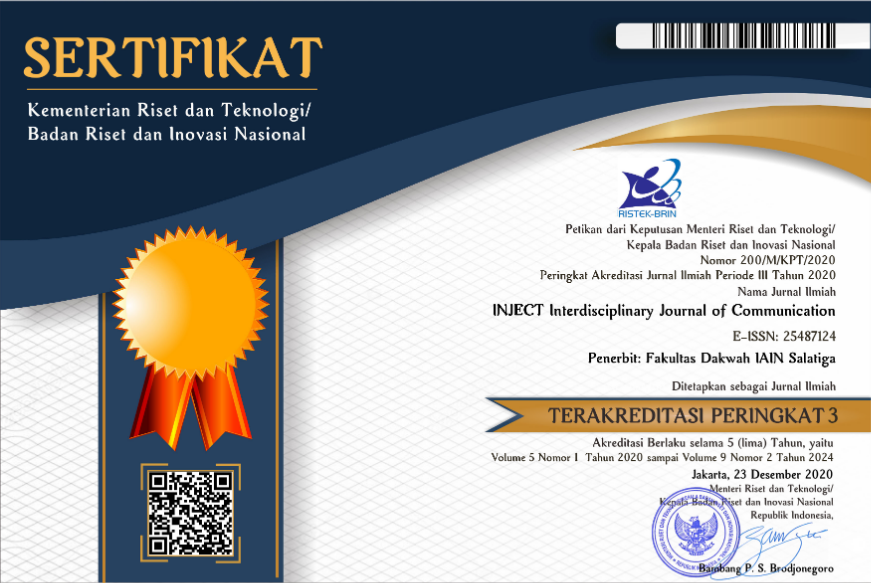What is Your Perception of Beauty? Culture Communication From Generation to Generation
Abstract
Keywords
Full Text:
PDFReferences
Baldwin, Jhon R et all. 2004. Commuication Theories for Everyday Life. Pearson Education, Inc. United States of America.
Cash, T. F. 1990. The psychology of physical appearance: Aesthetics, attributes, and images. Available at : http://psycnet.apa.org/psycinfo/1990-98350-003. February 12, 2017.
Casmini, C. 2015. Implikasi Pemaknaan Cantik Terhadap Pelaksanaan Tata Tertib Mahasiswa. Jurnal Hisbah, 12 (1).
Christanti, O. N., & Raditya, A. 2013. Konstruksi Perempuan Cantik Di Kalangan Siswi SMAN 1 Sooko Mojokerto. Jurnal Mahasiswa Teknologi Pendidikan, 1 (3).
Coman, R., & Scarlat, C. 2014. The modern woman image as reflected by current media. Journal of Research in Gender Studies, (1): 905-914.
Conley, T. D. 2013. Beautiful, Self-Absorbed, and Shallow: People of Color Perceive White Woman as an Ethnically Marked Category. Journal o Applied Social Pscychology, 43 (1): 45-54
Fisher, B Aubrey, dan Katherine L Adam. 1994. Interpersonal Communications Pragmatics of Human Relationships. New York: McGraw-Hill, Inc.
Gan, P. C. B. 2016. Ethics Precedes Religious Beliefs: The Basis of Solidarity. KEMANUSIAAN: The Asian Journal of Humanities, 23 (2).
Gudykunts, William B. 1983. Intercultural Communication Theory Current Perspektif. New York. Sage Publications Baverly Hills
Hao, Y., & Chi, R. 2013. Politeness Principle in Human Communication. Studies in Sociology of Science, 4 (3), 54.
Julian, R. 2016. Mitos Kecantian Dalam Cerpen-Cerpen Dwi Ratih Ramadahny. Jurnal POETIKA, 4(1): 52-60.
Kaner, A. 2015. Book Review: The Psychology of Beauty: Creation of a Beautiful Self. Journal of the American Psychoanalytic Association, 63(1): 172-176.
Kartika ,T. 2016. Konstruksi Makna Cantik dan Tampan Pada Mahasiswa Dalam Kajian Kearifan Lokal dan Ekonomi Media. University of Lampung.
Kartika ,T. 2016. And Food Agency Badan Pom Republik Indonesia. The Social Sciences, 11 (7): 1350-1354.
Kyo.C. 2016. The Search for the Beautiful Woman: A Cultural History of Japanese and Chinese Beauty. The Asia-Pacific Journal Japan Focus Volume,14(16).
Milutinovic, J., Zelic, K., & Nedeljkovic, N. 2014. Evaluation of facial beauty using anthropometric proportions.The Scientific World Journal, 2014.
Mengulik Data Suku Di Indonesia (2020) Available at: https://www.bps.go.id/news/2015/11/18/127/mengulik-data-suku-di-indonesia.html
Michel, A. 2014. Beautiful Disease: “The Story of Angelina Jolie’s Mastectomy in the American Media”. Available at : http://epublications.marquette.edu/dittman/14/. February 12, 2017.
Novitri, P. 2013. The Representation of Beautiful Women in Skin-Whitening Cosmetics TV Commercials (Doctoral dissertation, Universitas Pendidikan Indonesia).
O’Brien, K. S., Daníelsdóttir, S., Ólafsson, R. P., Hansdottir, I., Fridjonsdottir, T. G., & Jónsdóttir, H. 2013. The relationship between physical appearance concerns, disgust, and anti-fat prejudice. Body Image, 10(4): 619-623.
Pérez, F. M. I. 2016. Cultural Values and Impolite Behaviour. The Case of Spaniards and North-Americans. Miscelánea: A Journal of English and American Studies, 53.
Penduduk menurut wilayah dan agama yang dianut, 2010. Badan Pusat Statistik. Available at: http://sp2010.bps.go.id/index.php/site/tabel?tid=321
Rahardjo, S., Hagijanto, A. D., & Maer, B. D. A. 2016. Mitos Kecantikan Wanita Indoensia Dalam Iklan Televisi Produk Citra Era Tahun 1980-an, 1990-an dan 2010-an. Jurnal DKV Adiwarna, 1, 14.
Raharjo, I., Wahyudi, A. B., Hum, M., Wahyudi, A. B., & Hum, M. 2016. Penggunaan Kata Cantik Dalam Majalah Wanita Femina, Kebaya Dan Kartini Edisi Oktober, November, Desember 2015 Dan Penerapannya Dalam Pelajaran Bahasa Di Sekolah (Doctoral dissertation, Universitas Muhammadiyah Surakarta).
Samovar, Larry, A, dan Richard, E Porter. 1981. Understanding Intercultural Communication. California: Wadsworth Publishing Company.
Universitas Lampung, Available at : http://www.unila.ac.id/fakultas/. January 24, 2017
Sulaiman, S.,at all. 2018. Negotiating Muslim Women's Rights and Identity in American Diaspora Space: An Islamic Feminist Study of Kahf's The Girl in the Tangerine Scarf. KEMANUSIAAN: The Asian Journal of Humanities, 25(1).
Wood, Julia T. 1997. Communcation in Our lives. Wadsworth Publishing Company. United States Of America.
Yeung, E. 2015. White and Beautiful: An Examination of Skin Whitening Practices and Female Empowerment in China. On Our Terms: The Undergraduate Journal of the Athena Center for Leadership Studies, 3(1).
Zare, B., Javadi, F., & Naseri, S. 2014. Does It Make Me Beautiful? A Focus Group Discussion on Cosmetic Surgery. International Journal of Applied Sociology, 4(5): 126-132.
DOI: https://doi.org/10.18326/inject.v6i1.103-118
Refbacks
- There are currently no refbacks.
Copyright (c) 2021 Tina Kartika, Karomani Karomani

This work is licensed under a Creative Commons Attribution 4.0 International License.








